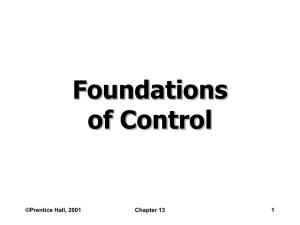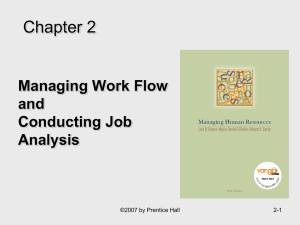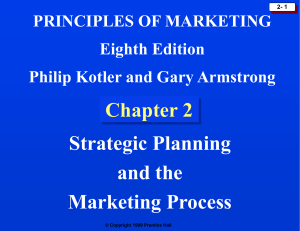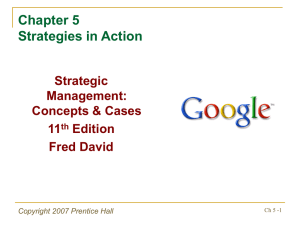File
advertisement
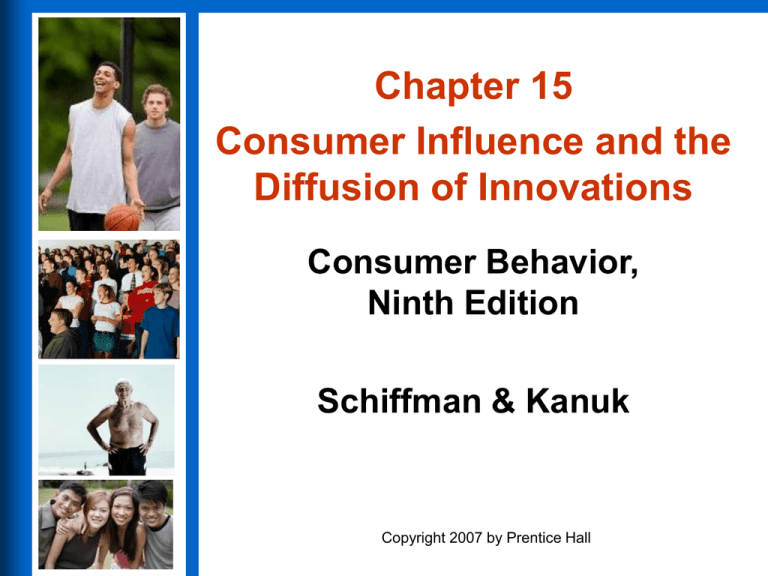
Chapter 15 Consumer Influence and the Diffusion of Innovations Consumer Behavior, Ninth Edition Schiffman & Kanuk Copyright 2007 by Prentice Hall Chapter Outline • • • • • • • What Is Opinion Leadership? Dynamics of the Opinion Leadership Process The Motivation Behind Opinion Leadership Measurement of Opinion Leadership The Interpersonal Flow of Communication Diffusion of Innovations The Adoption Process Copyright 2007 by Prentice Hall 15 - 2 Opinion Leadership Copyright 2007 by Prentice Hall The process by which one person (the opinion leader) informally influences the consumption actions or attitudes of others who may be opinion seekers or opinion recipients. 15 - 3 What Is Opinion Leadership? Opinion Leader Opinion Receiver Opinion Seeker Copyright 2007 by Prentice Hall 15 - 4 Word of Mouth in Action Figure 15-1 Copyright 2007 by Prentice Hall 15 - 5 Discussion Question • Who are the most influential opinion leaders to college-aged people? • Why are they influential? Copyright 2007 by Prentice Hall 15 - 6 Dynamics of the Opinion Leadership Process • Credibility • Positive and Negative Product Information (favorable or unfavorable) • Information and Advice either to buy or not • Opinion Leadership Is Category-Specific specialized in cretin product • Opinion Leadership Is a Two-way Street Who are opinion leader in one product will be opinion leader receiver in another Copyright 2007 by Prentice Hall 15 - 7 Motivations Behind Opinion Leadership Issues • The Needs of Opinion Leaders • The Needs of Opinion Receivers • Purchase Pals • Surrogate Buyers versus Opinion Leaders Copyright 2007 by Prentice Hall • Self-involvement Feel like adventurer • Social involvement Express friendship by discussion products that may be useful for others • Product involvement Express satisfaction or dissatisfaction with product • Message involvement Telling others about it 15 - 8 Motivations Behind Opinion Leadership Issues • The Needs of Opinion Leaders • The Needs of Opinion Receivers • Purchase Pals • Surrogate Buyers versus Opinion Leaders Copyright 2007 by Prentice Hall • New product or new usage information • Reduction of perceived risk • Reduction of search time • Receiving the approval of the opinion leader 15 - 9 Motivations Behind Opinion Leadership Issues • The Needs of Opinion Leaders • The Needs of Opinion Receivers • Purchase Pals (friend ship) • Surrogate Buyers versus Opinion Copyright 2007 by Prentice Hall Leaders • Actually accompany consumers on shopping trips • Used 25 percent of the time for purchases of electronic equipment 15 - 10 Motivations Behind Opinion Leadership Issues • The Needs of Opinion Leaders • The Needs of Opinion Receivers • Purchase Pals • Surrogate Buyers versus Opinion Leaders Copyright 2007 by Prentice Hall • Surrogate buyers may replace opinion leaders • An example is a wardrobe consultant who helps in the purchase of business clothes 15 - 11 Table 15.3 Key Differences Between Opinion Leaders and Surrogate Buyers Part I: Opinion Leaders OPINION LEADER 1. Informal relationship with end users 2. Information exchange occurs in the context of a casual interaction 4. Does not get paid for advice 5. Usually socially more active than end users 6. Accountability limited regarding the outcome of advice 8. Likely to have used the product personally 9. More than one can be consulted before making a final decision 10. Same person can be an opinion leader for a variety of related product categories Copyright 2007 by Prentice Hall 15 - 12 Table 15.3 Key Differences Between Opinion Leaders and Surrogate Buyers Part II: Surrogate Buyers SURROGATE BUYER 1. Formal relationship; occupation-related status 2. Information exchange in the form of formal instructions/advice 4. Usually hired, therefore gets paid 5. Not necessarily socially more active than end-users 6. High level of accountability 7. Search and screening of alternatives more rigorous 8. May not have used the product for personal consumption 9. Second opinion taken on rare occasions 10. Usually specializes for a specific product/service category Copyright 2007 by Prentice Hall 15 - 13 Measurement of Opinion Leadership • • • • Self-Designating Method Sociometric Method Key Informant Method Objective Method Copyright 2007 by Prentice Hall 15 - 14 Discussion Question • Who do you know, personally, that you would consider an opinion leader? • What is it about that person that makes them an opinion leader? What personality traits might they have which prompt their status? Copyright 2007 by Prentice Hall 15 - 15 Table 15.4 Measuring Opinion Leadership OPINION LEADERSHIP MEASUREMENT METHOD DESCRIPTION OF METHOD SAMPLE QUESTIONS ASKED SELF-DESIGNATING METHOD Each respondent is asked a series of questions to determine the degree to which he or she perceives himself or herself to be an opinion leader. “Do you influence other people in their selection of products?” SOCIOMETRIC METHOD Members of a social system are asked to identify to whom they give advice and to whom they go for advice. “Whom do you ask?”“Who asks you for info about that product category?” Copyright 2007 by Prentice Hall 15 - 16 Table 15.4 continued OPINION LEADERSHIP MEASUREMENT METHOD DESCRIPTION OF METHOD SAMPLE QUESTIONS ASKED KEY INFORMANT METHOD Carefully selected key informants in “Who are the most a social system are asked to influential people in designate opinion leaders. the group?” OBJECTIVE METHOD Artificially places individuals in a “Have you tried the position to act as opinion leaders product?” and measures results of their efforts. Copyright 2007 by Prentice Hall 15 - 17 Table 15.6 Profile of Opinion Leaders GENERALIZED ATTRIBUTES ACROSS PRODUCT CATEGORIES Innovativeness Willingness to talk Self-confidence Gregariousness Cognitive differentiation Copyright 2007 by Prentice Hall CATEGORY-SPECIFIC ATTRIBUTES Interest Knowledge Special-interest media exposure Same age Same social status Social exposure outside group 15 - 18 Market Maven Copyright 2007 by Prentice Hall Individuals whose influence stems from a general knowledge or market expertise that leads to an early awareness of new products and services. 15 - 19 The Interpersonal Flow of Communication • Two-Step Flow – A communication model that portrays (represent) opinion leaders as direct receivers of information from mass media sources who, in turn, interpret and transmit this information • Multistep Flow – A revision of the traditional two-step theory that shows multiple communication flows Copyright 2007 by Prentice Hall 15 - 20 Two-Step Flow of Communication Theory Figure 15.3 Copyright 2007 by Prentice Hall 15 - 21 Multistep Flow of Communication Theory Figure 15.4 Copyright 2007 by Prentice Hall 15 - 22 Issues in Opinion Leadership and Marketing Strategy • Advertisements Stimulating Opinion Leadership • Word of Mouth May Be Uncontrollable eGo Bikes Video Copyright 2007 by Prentice Hall 15 - 23 Marketers Seek to Take Control of the Opinion Leadership Process • Creating products with built-in buzz potential let customers talk about it • Strategy designed to stimulate buzz web site or hire actors • Viral marketing marriage of e-mail and word mouth it allow massage to spread as viral Copyright 2007 by Prentice Hall 15 - 24 Proctor & Gamble Uses Tremor to Influence Buzz Marketing weblink Copyright 2007 by Prentice Hall 15 - 25 Diffusion Process Copyright 2007 by Prentice Hall The process by which the acceptance of an innovation is spread by communication to members of social system over a period of time. 15 - 26 Adoption Process Copyright 2007 by Prentice Hall The stages through which an individual consumer passes in arriving at a decision to try (or not to try), to continue using (or discontinue using) a new product. 15 - 27 Elements of the Diffusion Process • • • • The Innovation The Channels of Communication The Social System Time Copyright 2007 by Prentice Hall 15 - 28 Defining Innovations • Firm-oriented definitions – Product is “new” to the company • Product-oriented definitions – Continuous modified product • Market-oriented definitions – Based on consumer exposure purchased in small quantity present short time • Consumer-oriented definitions – Consumer judges it as “new” Copyright 2007 by Prentice Hall 15 - 29 What type of product innovation is this product? Copyright 2007 by Prentice Hall 15 - 30 Product Characteristics That Influence Diffusion • Relative Advantage • Compatibility match the needs of customers • Complexity difficult to use • Trialability • Observability attributes ,benefits observed Copyright 2007 by Prentice Hall 15 - 31 Time and Diffusion • Purchase Time times needed to aware new products • Adopter Categories • Rate of Adoption Copyright 2007 by Prentice Hall 15 - 32 Adopter Categories Copyright 2007 by Prentice Hall A sequence of categories that describes how early (or late) a consumer adopts a new product in relation to other adopters. 15 - 33 Adopter Categories Figure 15.8 Copyright 2007 by Prentice Hall 15 - 34 Discussion Question • Which adaptor category are you? • Does it differ with different product categories? • How about your parents, what category are they? • Is age a factor in innovation behavior? Copyright 2007 by Prentice Hall 15 - 35 Table 15.14 Stages in Adoption Process WHAT HAPPENS NAME OF DURING THIS STAGE STAGE EXAMPLE Awareness Consumer is first exposed to the product innovation. Eric sees an ad for a 23-inch thin LCD HDTV in a magazine he is reading. Interest Consumer is interested in the product and searches for additional information. Eric reads about the HDTV set on the manufacturer’s Web site and then goes to an electronics store near his apartment and has a sales person show him the unit. Evaluation Consumer decides whether or not to believe that this product or service will satisfy the need--a kind of “mental trial.” After talking to a knowledgeable friend, Eric decides that his TV will fit nicely on top of the chest in his bedroom. He also calls his cable company and finds out that he can exchange his “standard” cable box at no cost for an HDTV cable box. Copyright 2007 by Prentice Hall 15 - 36 Table 15.14 Stages in Adoption Process WHAT HAPPENS NAME OF DURING THIS STAGE STAGE Trial Adoption (Rejection) Consumer uses the product on a limited basis If trial is favorable, consumer decides to use the product on a full, rather than a limited basis--if unfavorable, the consumer decides to reject it. Copyright 2007 by Prentice Hall EXAMPLE Since the HDTV set cannot be “tried” like a small tube of toothpaste, Eric buys the TV at this local electronics store on his way home from work. The store offers a 14-day full refund policy. Eric loves his new HDTV set and expects many year of service from it. 15 - 37 Issues in Profiling Consumer Innovators • • • • • • Defining the Consumer Innovator 2.5% Interest in the Product Category early adopters The Innovator Is an Opinion Leader Personality Traits Social Characteristics Demographic Characterist Copyright 2007 by Prentice Hall 15 - 38



